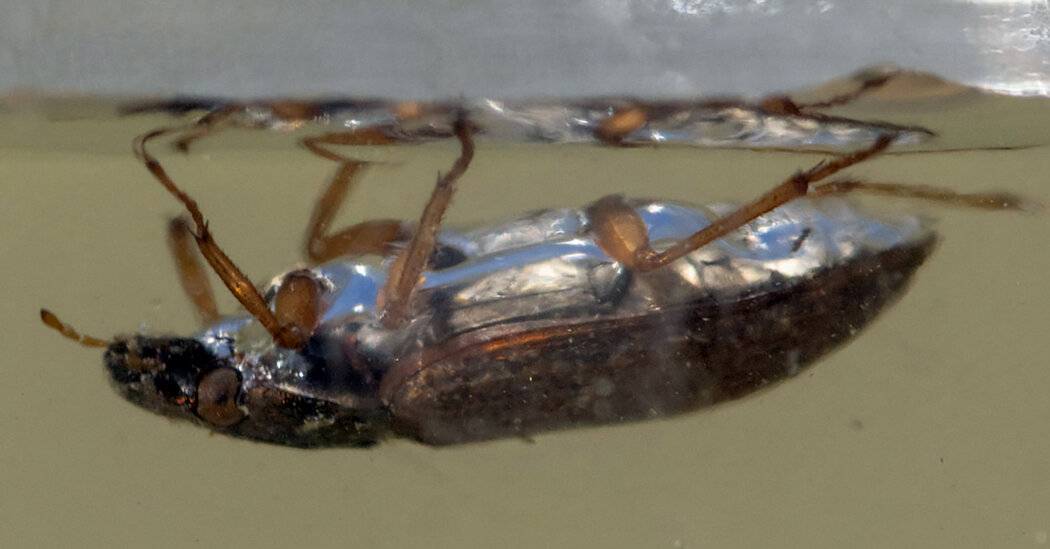After dark, the Watagan Mountains in New South Wales, Australia, can appear otherworldly to anyone with a headlamp. But things turned stranger than usual in 2015 when John Gould, a behavioral ecologist at the University of Newcastle in Australia, was surveying sandpaper frogs in the forests’ ephemeral pools for his dissertation.
Dr. Gould was crouching upon a pool, seeking frogs, when he saw a pea-sized bug that he thought had fallen into the water. As he peered closer, Dr. Gould realized he was not watching a right-side-up bug struggling to escape the water, but an upside-down beetle in full control of its life and current situation. It skittered along the undersurface of the water as if in a parallel world, the kneeling Dr. Gould beneath him.
The surface of the pool was immaculately still, nary a wind ripple in sight, and Dr. Gould pulled out his phone to record the water scavenger beetle’s nonchalant ceiling crawl. Because the footage was unrelated to his research, Dr. Gould stored the beetle video in his files and did not return to it for several years as he finished his doctorate. In June at last, Dr. Gould and Jose Valdez, a wildlife ecologist at the German Centre for Integrative Biodiversity Research in Leipzig, published the first detailed documentation of this behavior in beetles in the journal Ethology.
Martin Fikáček from National Sun Yat-sen University, Taiwan, was not involved with the initial research but identified the bug as a water scavenger beetle, likely in the family Hydrophilidae.
Though the paper represents the first time the beetle’s upside-down underwater crawl has been recorded in the literature, the behavior has been reported before, according to Manu Prakash, a bioengineer at Stanford University who was not involved with the research. “It’s a beautiful observation,” Dr. Prakash wrote in an email.
The water scavenger’s movements differ from the traditional way to walk on water, which is on the top of it. Sea and water striders row themselves across the surface of water with oar-like legs. With the help of surface tension, some geckos can run across water by undulating their bodies and slapping the surface of the water with their legs.
Under the water, some creatures do live inverted lives. Many are snails. In the ocean, the violet snail clings upside-down to the surface of the ocean with a sticky raft of bubbles that keeps its shelled body afloat. The freshwater snail Sorbeoconcha physidae also relies on mucus, wrinkling its foot against the surface of the water to putter along. “They use a different mechanism since they do not have legs,” Dr. Valdez clarified, of snails.
In freshwater, some insects called backswimmers swim upside-down, rowing their hairy hind legs under the water. The larvae of the aquatic fly Dixidae, also called meniscus midges, use the hairy structures on their abdomen to attach, upside-down, to the surface of the water.
But these aquatic water scavenger beetles do not swim like the backswimmer or the larvae. They walk, just as one might imagine a terrestrial beetle species walks on land, or skitters along your ceiling.
The first question: How?
“It’s a bit of a question mark,” Dr. Gould admitted, though he and Dr. Valdez have some hypotheses.
One possibility, the researchers say, is an air bubble clinging to the belly-up beetle, which could be providing upward buoyancy keeping the beetle aloft. Though a bubble so near the surface would seem bound to pop, the beetle’s bubble remained resolutely full, suggesting that the bug is somehow preventing the air’s escape, the researchers say. Beetles that can walk (right-side-up) underwater have been known to trap air bubbles between their feet.
The second question: Why??
Though the beetle’s feet appeared to prick the water with each step, its low-profile jaunt produced no ripples. The researchers suggest this locomotion style might help the bug avoid being eaten by anything lurking nearby. “Any predators above the surface may be looking down and seeing a bubble instead of a tasty treat,” Dr. Valdez wrote in an email.
Moving through the drag, buoyancy and viscosity of water usually requires more energy than moving on land. But the beetle seemed able to move quite easily and even appeared to rest upside-down, which seems to suggest this behavior is not energetically taxing, the authors say.
But the only way to know any of this for sure would be to take the beetle species into a lab for further research.
Now, Dr. Gould studies another frog on Kooragang Island, not far from the Watagans, that breeds in artificial wetland ponds around the island’s coal ports. Nature is less pristine there but still bears tiny wonders; recently, Dr. Gould saw a slug twirl elegantly to the ground from the top of a fence like an aerial artist, using a strand of its own mucus like a climbing rope.
And what of this particular beetle? Water scavengers have a short life span, so this particular beetle is likely gone, its body returned to the petrichor-scented soil of the Watagans. But other beetles remain, living and dying and walking on any surface that will hold them.
Source: Read Full Article

